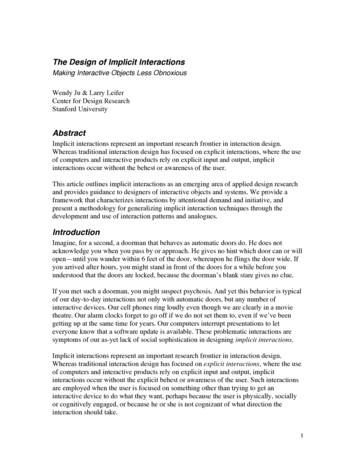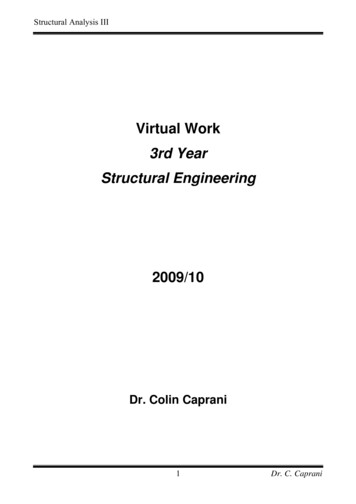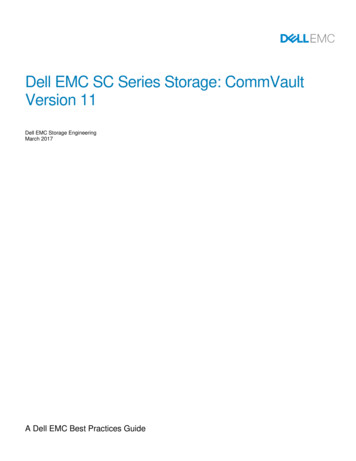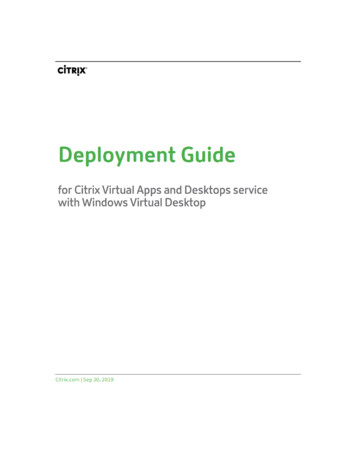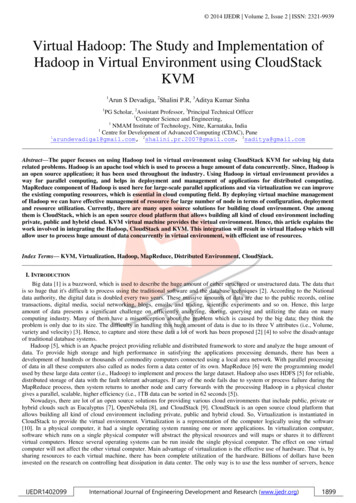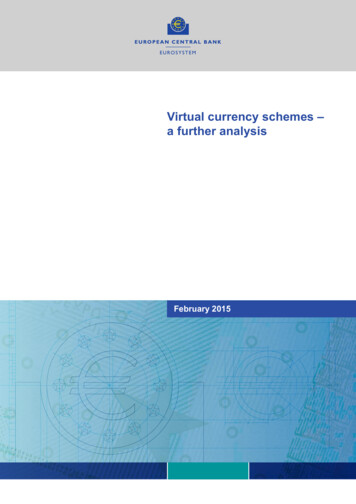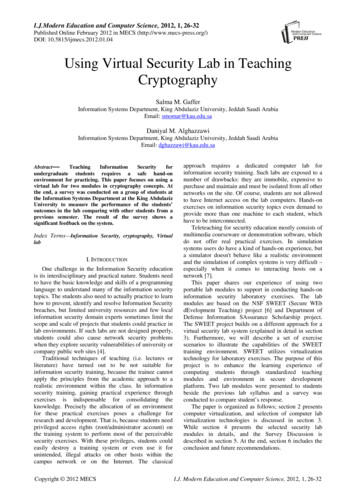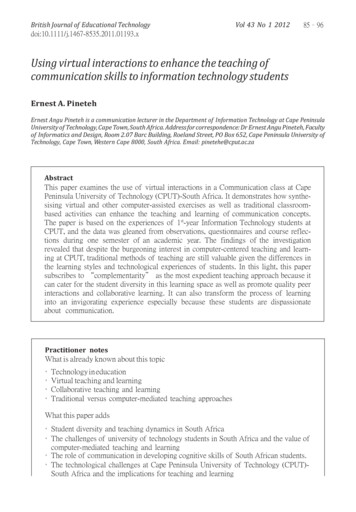
Transcription
British Journal of Educational Technologydoi:10.1111/j.1467-8535.2011.01193.xVol 43 No 1 201285 96Using virtual interactions to enhance the teaching ofcommunication skills to information technology studentsErnest A. PinetehErnest Angu Pineteh is a communication lecturer in the Department of Information Technology at Cape PeninsulaUniversity of Technology, Cape Town, South Africa. Address for correspondence: Dr Ernest Angu Pineteh, Facultyof Informatics and Design, Room 2.07 Barc Building, Roeland Street, PO Box 652, Cape Peninsula University ofTechnology, Cape Town, Western Cape 8000, South Africa. Email: pinetehe@cput.ac.zaAbstractThis paper examines the use of virtual interactions in a Communication class at CapePeninsula University of Technology (CPUT)-South Africa. It demonstrates how synthesising virtual and other computer-assisted exercises as well as traditional classroombased activities can enhance the teaching and learning of communication concepts.The paper is based on the experiences of 1st-year Information Technology students atCPUT, and the data was gleaned from observations, questionnaires and course reflections during one semester of an academic year. The findings of the investigationrevealed that despite the burgeoning interest in computer-centered teaching and learning at CPUT, traditional methods of teaching are still valuable given the differences inthe learning styles and technological experiences of students. In this light, this papersubscribes to ce e tarity as the most expedient teaching approach because itcan cater for the student diversity in this learning space as well as promote quality peerinteractions and collaborative learning. It can also transform the process of learninginto an invigorating experience especially because these students are dispassionateabout communication.Practitioner notesWhat is already known about this topic Technology in educationVirtual teaching and learningCollaborative teaching and learningTraditional versus computer-mediated teaching approachesWhat this paper adds Student diversity and teaching dynamics in South Africa The challenges of university of technology students in South Africa and the value ofcomputer-mediated teaching and learning The role of communication in developing cognitive skills of South African students. The technological challenges at Cape Peninsula University of Technology (CPUT)South Africa and the implications for teaching and learning
86British Journal of Educational TechnologyVol 43 No 1 2012Implications for practice and/or policy Use computer-mediated teaching and learning as a complementary tool in context ofSouth Africa Develop curricula that promote collaborative teaching and learning either in class oronline. Place communication at the core of teaching and learning in the InformationTechnology (IT) department at CPUT-South Africa in order to develop critical softskills.IntroductionOne fascination of the 21st century is the way computers and other mobile technologies arereconfiguring the lives of human beings (Martin & Madigan, 2006). Today, many schools anduniversities are equipped with different technological devices, compelling learners and teachersto immerse in mobile and computer-mediated activities in a very uncharacteristic way (Shana,2009; Yang, 2009). Digital interactivity has therefore provided both teachers and learners withan alternative avenue to construct and reconstruct knowledge (Yang, 2009, p. 12). It has alsointroduced them to new literacies such as digital, media and cooperative literacy (Martin &Madigan, 2006). Furthermore, the increasing presence of technology in teaching and learningspaces suggests that traditional approaches, characterised by the roles of authoritarian teacherand passive learning, are dissipating rapidly, creating new spaces for more constructivist learning (Shana, 2009, p. 215).But is this the end of the road for traditional models in South African universities? In this paper,I answer this question by scrutinising computer-mediated communication activities administeredto 1st-year students in the Information Technology (IT) department at Cape Peninsula Universityof Technology (CPUT). In this learning space, I envisioned emancipating students from a largelytheoretical subject, often taught in a pedantic style. Also, I hoped to uncover how the virtualisation of communication teaching, a road less travelled especially at CPUT, can impact on teachingand learning. The paper presupposes that in the age of social media, the teaching of communication skills to this generation of learners engenders the formulation of innovative teachingstrategies, which can stimulate the construction and exchange of knowledge beyond the confinesof a classroom. However, channelling all our efforts to online teaching and learning couldbecome counter-productive in the nearest future, considering the pace at which technology isevolving. To guard against this rapid technological evolution, the paper subscribes to complementarity as the most expedient teaching approach. This approach provides a prism throughwhich students from diverse schooling backgrounds, such as those at CPUT, can construct andexchange knowledge as well as socially interface within and beyond the brick walls of a classroom(Andreatos, 2007; Pata, 2009; Shana, 2009). To legitimise the preceding claim, this paperdiscusses IT students’ virtual and classroom experiences and the implications for teaching andlearning. It focuses on the demerits of visual interactions and the challenges of computer-driventeaching and learning at CPUT.Conceptualising computer-assisted teaching and learningBefore the irruption of technology in education, teaching and learning was informed by anobjectivist or traditional model. This model imaged teaching as the transfer of knowledge fromthe omniscient teacher to the learner. It was primarily teacher centered and reductionist,restricted visibly by time, space and place (Crawford, 1996; Piccoll, Ahmad & Ives, 2001). Today,the scholarship of teaching and learning has taken many detours, opening space for myriadinstructional paradigms. For example, the inception of social constructivism has revolutionised.
Enhancing the teaching and learning of communication skills87the transfer of knowledge. Pioneered by Lev Vygotsky, this theoretical conception contends thatknowledge is enmeshed in personal experiences that are socially and culturally constructed. ForVygotsky and his followers, teaching and learning should therefore be learner centered, collaborative and negotiated heuristically through different social interactions either in a traditionalclassroom or in a virtual space (Crawford, 1996; Driscoll, 1994). Furthermore, the increasingpresence of technology in schools and universities has led to the proliferation of the virtuallearning environments (VLEs). This proliferation can be blamed on the claim that technologymediated teaching and learning improves student performance, dispel students’ attitudestowards learning and increases their levels of social interactions (Dillon, 2004; Longhurst &Sandage, 2004; Piccoll et al, 2001; Williams, 2008). These different teaching and learningmodels have provided educators with the opportunity to blend different strategies in the samelearning space.Moreover, studies on educational technology have repeatedly echoed the ubiquity of computersand other digital devices in schools/universities and the way it impacts on teaching and learning(Scharber, 2009; Shana, 2009; Yang, 2006). This is because the current generation of studentsare more technologically conscious and brings to tertiary institutions a wide range of life experiences and interests (Lillis, 2003, p. 192). For instance, in schools and universities, learnersspend hours interfacing with their peers on computer or mobile devices (Carter, Foulgar &Ewbank, 2008; Saeed, Yang & Sinnappan, 2009; Wintour, 2009). Some of these activities involvememorization, motivation and, to some extent, modelling of different behavioural patterns. Forsocial learning theorists and proponents of VLE, these mental activities can enhance the cognitivedevelopment of learners. In contrast, the introduction of technology in education at CPUT is stillfraught with challenges such as uncontrollable disruptions, an overwhelming lack of commitment from students and the diverse interests that South African learners bring to the university(Ng’ambi, 2003). Also, virtual interactions mean learners are able to access huge amounts ofinformation and also connect with a wider population of peers. Seemingly, these dynamics havehad negative implications for the way students socialise online and in the classroom (Cross, 2004;Wintour, 2009).I am not insinuating that computers and other mobile devices are not suitable for teaching andlearning. Neither am I mystifying the application of virtual interactions in any learning environment. Epistemologically, the increasing presence of web technologies such as blogs, wikis,instant messages . podcasts and vodcasts has compelled educators to be more imaginative andencouraged the use of teaching methods that are more stimulating and appealing to learners. Forexample, Virvou, Katsionis and Manos (2005) encourage the use of games to enhance theeffectiveness of teaching and learning. The paper argues that given the complex nature of learning, using educational games does not only enhance students’ ability to think critically andcollaboratively but also makes teaching and learning more stimulating and less stressful. Thissuggests that learning is not just about knowledge, but also about motivation, engagement andsocial interactions (Dettori, Gianneti, Paiva & Vaz, 2006: 5). The text advocates creativity andinnovation when designing curricula, given that computer gaming is an emergent media literacyin today’s learning environment. Additionally, in the context of communication teaching, educational games are likely to enhance critical, analytical and problem-solving skills as well asenhance students’ abilities to synthesise knowledge. However, promoting a gaming culture atCPUT can be quite challenging, considering the quality of its current technological facilities andthe disturbing reality that most of its students are from underprivileged backgrounds and mightnot be able to afford games designed specifically for educational purposes. Even if the universityhad to provide computers with educational games, most 1st-year students might lack the metacognitive ability to apply the gaming experiences to their own academic development (Ng’ambi,2003).
88British Journal of Educational TechnologyVol 43 No 1 2012Nevertheless, digital technologies have provided endless opportunities for exchanging understanding, interpreting and organizing . knowledge across different boundaries using differenttools (Lea & Street, 1998, p. 157). Yang (2009), on the use of blogs to enhance critical reflection, reinforces the importance of computer-assisted conversations in promoting collaborativelearning. For Yang, blogging provides an unrestricted and more accessible space for learnersand educators to exchange and localize new information based on their personal needs andliving environments (Yang, 2009, p. 12). This paper lends itself to the Vygotsky-based theorythat learning is a process of social constructivism, shaped today by the quality of virtual relationships and dialogic engagements with peers and educators inside and outside the conventional classroom. Significantly, this type of interaction stimulates peer teaching, positioning thelearner at the epicentre of teaching and learning. It can also enhance learners’ critical andreflective thinking skills key objectives of communication (Jeong & Frazer, 2008; Lim & Chai,2007).The shift to virtual interactions seems to signal that the traditional scholarship is phasing out,creating avenues for technologically enhanced learning spaces that can drive meaningful interactivity and intellectual exchanges between students and educators (De Freitas & Jameson, 2006;Martin & Madigan, 2006; Shana, 2009). This new pedagogical trajectory can offer learners ofall ages, myriad opportunities for informal, collaborative and autodidactic learning outside . anytraditional boundaries whether . geographical, temporal or pedagogical (Dyer & Jonson, 2006,p. 183). For the purveyors of VLE, learning in the age of technology should be a borderless socialexperience, involving intellectual collaboration and exchange between students and lecturers. Inthis light, Dettori et al (2006)’s Technology-Mediated Narrative Environments for Learningre-engages with the notion of socialisation and collaborative learning in a unique way: storytelling. The text recreates an ancient tradition through open narrative-oriented software, capableof integrating different communicative skills such as speaking, listening, writing and reading. Itre-affirms the value of story telling as a prism to connect repertoires of human skills such as theability to remember episodes in a systemic way and imaginatively reconstruct them to appeal toan audience. This interplay of different skills is essential in handling communication tasks suchas academic writing, public speaking, debates and oral presentations.These studies foreground computer-assisted teaching and learning in this day and age, seeminglyoblivious of the peculiarity of each learning context. In several African schools and universities,the application and development of VLE have tended to suffer from the lack of sufficient humanand material resources, students’ inability to manage vast and complex information from variedInternet sources and increasing social demands as well as the discrepant learning styles andpersonalities of students. Despite these challenges, virtual teaching and learning is arguably afascinating approach especially considering the rapid technological changes and how thesechanges are reconfiguring human lives. Virtual interactions between students and educatorspromote greater cognitive flexibility (Wolfe, 2001, p. 6), which can enable students to interactin a less intimidating and socially oriented atmosphere. It can also enhance the dissemination ofknowledge to a wider community of learners (Jeong & Frazer, 2008; Ng’ambi, 2003; Oxford,2006). Here, learning is depersonalised, inviting the shy and marginalised who are often intimidated by their classmates to add their voices to discussions on teaching and learning (Maier &Warren, 2000; Martin & Madigan, 2006).This does not mean the traditional model has become obsolete and VLE is the replacement. AtCPUT, the traditional classroom-based style is still essential because it caters for the learningneeds of students with weaker computer skills. This category of students lacks the intellectualacumen and/or the sense of commitment as well as the cognitive development to compete withthe few intelligent and highly computer-literate peers. And because their computer skills areunnerving, they often battle to interpret the complex bodies of information gleaned from different.
Enhancing the teaching and learning of communication skills89Internet websites. To address this challenge, I blended the different models in my Communicationclasses. This strategy did not only promote imaginative thinking and creativity, but it also helpedto transform the process of teaching and learning into socially situated discourse practice(Lillis, 2003, p. 192).Methods of data collectionThe data for this paper were gleaned from several online and classroom-based activities with my1st-year IT students approximately 180 students. The students were diverse in terms of race,sex, learning styles and social backgrounds. However, black males from previously disadvantagedcommunities constituted the majority. The data collection process began with myriad onlineactivities facilitated on my social network Kommunicare. Here, I closely observed and managedthe activities during and after the lectures. I was a participant observer, engaging with studentson different levels and on a range of topics. During observations, I monitored and recorded theway students responded to topics on Kommunicare and the emergent social relationships after theinteractions. Several oral discussions also crept in during the observations, where students intermittently shared their online experiences. Key online activities included discussions, feedback,blogging, language exercises and debates. I then interlaced the virtual interactions withclassroom-based face-to-face activities such as role-playing, simulated oral interviews and oralpresentations. In class, I videotaped and photographed some of the face-to-face activities, and thefootage and photos were populated on Kommunicare, and learners were invited to critique the waytheir peers handled those activities. I also administered online questionnaires to students at theend of the semester. The questions focused on students’ online and classroom experiences and theimplications for teaching and learning. After the collecting the data, I analysed my observationnotes, the completed questionnaires and the visual images. Here, I concentrated on emergingpatterns, trends, phenomena and student experiences that hinged on the complementaryapproach proposed in this paper. I also examined the impacts of online course reflections, feedback and discussions as well as classroom-based activities on the teaching and learning of communication concepts (see Appendices).Discussion of virtual interactions on a social network KommunicareEssentially, Kommunicare was set up to explore alternative ways of teaching critical skills such aswriting, reading, analytical and problem solving skills using less frightening computer-mediatedactivities and other virtual interactions. With this approach, I reckoned students would havemore time to engage with communication-related discussions and issues. I also hoped to encourage collaborative learning through online knowledge exchange (Chiang & Fung, 2004; Jeong &Frazer, 2008; Kayler & Weller, 2007). The space was therefore designed and equipped with toolsand virtual spaces for discussions, free writing, debate and other social interactions betweenstudents.The discussion forum provided an unrestricted space for students to blog and exchange views ona myriad of topics. Here, students were able to conceptualise and independently facilitate discussion topics and blogs with their peers. The topics ranged from key themes in the field of communication to topical socio-political issues in South Africa. These discussions did not only allow thelearner to be more flexible in terms of where and when they participate in a dialogue. They alsoallow a wider audience to read and participate in a discussion (Wolfe, 2001, p. 246). Despite therisk of infantilising learners’ minds (Wintour, 2009), the social network still managed to create aconvivial teaching space for both extroverts and introverts to analyse and debate issues. Thisapproach repositioned students as important stakeholders in the process of teaching and learning. In addition, the forum enhanced students’ ability to conceptualise topics, interpret, stateclaims and persuasively argue these claims using relevant supporting evidence. Taking students
90British Journal of Educational TechnologyVol 43 No 1 2012outside the usual physical space into a VLE, where they could engage in online conversations ontopical socioeconomic and political issues provided communication teaching with an unusualflair.The social networking approach also sought to encourage the exchange of reading, gaming andmovie experiences through regular online reviews. To achieve this objective, I set up a review pageto stimulate the sharing of diverse social experiences. Here, students with an affinity for games,movies or books reviewed and reflected on these social art forms. By reviewing books, articles,movies and games, students were able to practise analytical, critical and summarising/or paraphrasing skills, in a self-rhythmed and less traditional way (Emig, 1977, p. 126). Interestingly,students used these skills in other important activities such as online debate and free writing.Online debates and free writing activities attempted to stimulate apowerfulmultirepresentational mode for learning and how it can drive academic writing (Emig, 1977, p. 125).For example, free writing ignited the passion for writing because students were able to subvertsome of the rules of academic writing, giving them a greater sense of ownership (Maybin, n.d.:64). This approach boosted students’ confidence and enhanced their commitment to writing,inadvertently facilitating the introduction of academic writing. Most importantly, online activities offered students the chance to share their writing experiences and equally participate inreading and commenting on the writings of their peers. Moreover, in order to enhance theirwriting skills, I included some basic language exercises in the pool of activities, and students wereable to download and engaged with them, on and off campus, expanding their language studyand learning community beyond the physical classroom (Blackstone, Spiri & Naganuma, n.d.:1). Although on-line written communication suffers from a lack of social presence and manymetalinguistic and pragmatic cues (Wolfe, 2001, p. 245), students found the flexibility and lackof time pressure more convenient and conducive to deep thought (Wolfe, 2001, p. 246).Finally, I interlaced the online collaborative learning with anonymous online course reflections.Through the same medium, I provided students with formative feedback on their assignmentsand class activities accessible anywhere and at anytime. The reflections were valuable becausethey gave students the freedom to critically reflect on their own academic journey and myteaching strategies in an uninhibited way. Reflective exercises can also be facilitated in a traditional setting; however, the online approach generated more objective participation fromstudents, especially because the reflections were asynchronous and completely anonymous(see Appendices).Discussion of some key findings from questionnairesThis discussion attempts to excavate and interpret student activities and feedback using somebasic research procedures and protocols. Here, I compare and discuss interesting varying experiences in different learning spaces and how they legitimise the blended approach heralded in thispaper. The findings discussed below emerged out of student reflections on VLE and their myriadpractical experiences in the different learning spaces. The reflection questions were directedprimarily at students’ perceptions of communication, my teaching strategies, the computermediated activities and how the different online interactions could support classroom-basedactivities. They also focused on the implications of online and classroom experiences for students’understanding of key communication concepts (see Appendices). The findings are categorisedinto two themes: the benefits of virtual interactions and the demerits as well as the challenges inthe context of CPUT.The benefits of virtual interactions in a Communication class at CPUTStudent reflections revealed several values of social networking and the implications for teachingand learning at CPUT. The responses captured familiar benefits of social networking in a com.
Enhancing the teaching and learning of communication skills91munication context. Some of the benefits mentioned in the questionnaires were endless interactivity, the construction of virtual identities, a sense of community through shared experiences,unintimidated participation in discussion and knowledge exchange (Ng’ambi, 2003; Redfern &Naughton, 2002). In response to a question on the benefits of online discussions, one studentinterjected:. I like using kommunicare because it gives me the opportunity to share my views with students in othergroups. Also, it eases the sharing of files and information with students, instead of informing each studentseparately, or relying on word of mouth. We can post announcements and they are available for every oneto see . (Student response)This student echoes the value of information sharing and how social networking can facilitatecollaborative learning especially in a context in which time is a major constraint. For him, usingthis medium enables a majority of students to access information at the same time. The testimonyhighlights the importance of peer learning and knowledge exchange at tertiary institutions andthe implications for students’ academic development. When students share knowledge, theyestablish deeper relationships with peers and the lecturer, even beyond the concrete walls of aclassroom. Through social networking, learners were able to negotiate different identities indifferent social spaces through writing and reading. This promoted the development of differentliteracies and provided a platform to stimulate a culture of reading and writing amongtechnology-oriented students (Carter et al, 2008; Williams, 2008).Unrestricted knowledge exchange meant easier accessibility and internalisation of information.Virtual spaces such as Kommunicare therefore provide a friendlier and less nerve-wracking spacefor articulating experiences and knowledge sharing. The following excerpt captures a student’sresponse to a question about the values of virtual interactions. For this respondent, Kommunicare. enhanced teaching because it allowed members who do not even know one another to communicateeffectively via kommunicare.[sic] It built good relations between some people; some people made good friends.It has taught some people how to communicate effectively and formally . more people are able to participateunlike in a class an environment where others are too shy I guess to speak . (Student response)Firstly, this response reiterates the significance of student participation in a Communication classand how a culture of participation can facilitate the understanding of basic communicationconcepts. Secondly, it underscores the primacy of social relationships in the process of learning.Interestingly, this was evident from the new web of friendship, which developed after only asemester of virtual interactions. For this respondent, this site fostered increased opportunities forcollaborative activities, enabling students to be more enmeshed in the content material of thecourse (Carter & Click, 2006, p. 1).This new wave of online relationships was symptomatic of the diversity in the IT department andthe agency of cultural integration among students from different racial and cultural backgrounds. For some respondents, this approach also provided an alternative learning platform forstudents with cultural inhibitions and other phobias such as the fear of public speaking. Thequote below articulates one respondent’s opinion on a question that focused on the impact ofonline discussions on students’ academic development:. Kommunicare offers space to students who are not confident enough to speak in front of the class to expresstheir opinions and that makes Kommunicare better than traditional teaching methods [sic] . it gives themthe spirit to participate in discussions with their classmates. Most of us black students are always intimidatedby white students, we feel inferior and this prevents us from participating in class discussions . (Studentresponse)The findings indicated that respondents supported this mode of teaching and learning becausesocial networks provide a comfort zone for those intimidated by face-to-face communication.They are avenues for the often-silenced voices to subvert the social differences in South African
92British Journal of Educational TechnologyVol 43 No 1 2012universities by wrestling with peers on different topics without thinking of race or class. Here, thedisturbing sense of difference, which often impedes the academic development of many SouthAfrican students, seemed to dissipate, opening space for students to negotiate new identities intheir own social spaces (Considine, Horton & Moorman, 2009; Williams, 2008). Althoughvirtual interactions undermine the value of public speaking and affect learners’ self-confidence,this respondent claims the quality of online discussions nurtured an imaginary sense of ownership and freedom, key motivators for student academic development especially in post-apartheidSouth Africa.Moreover, students imagined this space as a community of practice for IT students. The followingrespondent capitalised on the online collaboration between learners and how it produced newcross-cultural social relationships, which could foster an invigorating learning environment. Forhim, these relationships paved the way for the process of constructing knowledge. I’ve talked to students on kommunicare that I’ve never met on campus beforehand [sic]. I now have agreater understanding and knowledge of these students and how they can contribute to my own academicdevelopment, something I believe I would never have been able to accomplish this otherwise [sic] . I amgetting to know them better, especially those from other groups . (Student response)This student attempts to respond to a question about active participation on Kommunicare. Here,they attempt to establish a link between social relationships and learning, espousing the socialconstructivist notion of collective generation [and exchange] of meaning (Crotty, 1998, p. 58).These relationships were formed through wrestling over provocative topics, and the intellectualboundaries created by the traditional group work model are subverted, forging a collective identity from a diversity of experiences. This means communication and a sense of community canoccur not only when students are physically co-present (Wolfe, 2001).The demerits and challenges of social
Also , I hoped to uncov er how the virtualisa- tion of communication teaching, a road less travelled especially at CPUT, can impact on teaching and learning. The paper presupposes that in the age of social media, the teaching of communi- cation skills to this generation of learners engenders the formulation of inno vative teaching .
